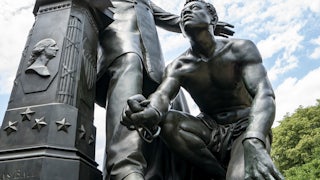Portraiture celebrating men who owned people has gazed down upon visitors to the U.S. Capitol for generations. But interestingly and tellingly, the slaver portraits had never been cataloged until December, when Washington Post history reporter Gillian Brockell found that one-third of the artwork in the Capitol depicts slavers or Confederates. That’s 141 slavers depicted in the Capitol’s oil paintings, marble busts, and statues of bronze and stone.
“If you’re Black or you’re brown or otherwise marginalized, it’s one of the first things you notice,” said Congresswoman Summer Lee of Pennsylvania, a new member of the Congressional Black Caucus. Jamaal Bowman agrees. “As a Black man at the Capitol, especially when I was a freshman, I always felt that I’m walking into the physical infrastructure of white supremacy,” said the New York Democrat and fellow CBC member.
“I also feel now obviously, in my second term, that my voice is incredibly important in changing that,” said Bowman.
“It could be updated,” agrees Shontel Brown, an Ohio Democrat also in her second term. Adds Emilia Sykes, another first-term CBC member from Ohio: “To come to the United States Congress and sit in the committee room, as I did today, and only see white men on the wall is a constant reminder of how much further we have to go to ensure that everyone feels like they belong in places of authority and in rooms of power.”
As House speaker, Kevin McCarthy has broad unilateral authority over the artworks that get displayed in the Capitol complex. In June 2021, then–Minority Leader McCarthy joined 59 of his GOP colleagues to pass a resolution to replace a slaver bust with an artwork of Thurgood Marshall. The New Republic asked McCarthy on Thursday if he would continue working with Democrats as speaker to modernize the Capitol’s artworks.
When @PabloReports asks if House Speaker Kevin McCarthy would be open to removing "depictions of slavers and Confederates" in the Capitol, McCarthy pivots to suggesting Democrats should "remove the name of their party." pic.twitter.com/exG68rM6QE
— The Recount (@therecount) February 2, 2023
“I remember when the Democrats brought up the removing of a couple statues,” said the California Republican. “I thought they should’ve gone further.… I think they should change the name of their own party.” McCarthy pointed out that Abraham Lincoln was a Republican and that Democrats were once the party of slavers. “There’s not one Republican that you have to take down,” he said of the Capitol artworks depicting Confederates.
House speakers typically rely on a designated arts-focused member of the Administration Committee to advise them on the Capitol artworks, according to former committee Chairwoman Representative Zoe Lofgren. “Most of the instigation of new art has come from the leadership,” said the California Democrat.
“I think the Confederacy represents a dark time in our history, not to be forgotten, but also shouldn’t be celebrated,” said embattled Congressman George Santos from New York. “Let’s ship these statues back to their states where they reserve the right to celebrate them, but I don’t think we should be celebrating Confederacy in the House.”
Each state gets two statues to display in the House. Twenty-three states display at least one slaver, while nine states display two statues of slavers, according to Brockell.
In July, Florida made history by replacing a statue of Confederate General Edmund Kirby Smith with a statue of educator and activist Mary McLeod Bethune, the first statue of a Black woman to be displayed in Statuary Hall. That same month, Kansas replaced a statue of former Senator John J. Ingalls with a statue of aviator Amelia Earhart.
“It’s nice to have a female representing our state in the Capitol,” said Senator Jerry Moran of Kansas. “It was a long process, expensive, so lots of communities who were most interested in this raised a lot of money to do it.” The Washington Post reports the statue of Earhart cost $175,000.
Arkansas has commissioned statues of country music legend Johnny Cash and civil rights activist Daisy Gatson Bates to replace the state’s statues of slavers Uriah Rose and James Clark. “You know the statue is getting a little dusty when the fella’s name is Uriah,” said Kevin Kresse, the artist behind the eight-foot-tall statue of Cash that The New Republic has confirmed was sent last month to be completed at a foundry in Norman, Oklahoma.
“It’s a net plus,” said Congresswoman Alexandria Ocasio-Cortez about Arkansas’s decision to replace its slaver artworks with statues of Bates and Cash. The two-term New York Democrat suggested statues of Franklin Delano Roosevelt and transgender rights advocate Sylvia Rivera would better represent her state than the monuments currently on display in the Capitol of slave trader Robert R. Livingston and early Governor George Clinton, who advocates say “perpetuated the institution of slavery during his tenure.”
“I’m sure if we took it to the state, there would just be an enormous amount of nominees,” said Ocasio-Cortez.
“Given the level of honor that it represents, I think we should be really thoughtful about the individuals who we continue to allow to be recognized with a monument,” said Congresswoman Lauren Underwood, a CBC member from Illinois. “I think it’s something really special and it’s an incredible honor to have your legacy of achievements recognized here.”
McCarthy deflected when asked if he will use his new office to change the Capitol artworks. While Democrats were once the party of slavery, Republicans’ role as the compassionate “Party of Lincoln” has become a distant memory to all but the most disingenuous messaging professionals who write talking points to wash over the overt anti-Blackness that has become a hallmark of today’s GOP. McCarthy will have to decide whether to embrace his party’s anti-Blackness or welcome a new generation of Capitol visitors to better, modern artworks that don’t depict enslavers.






